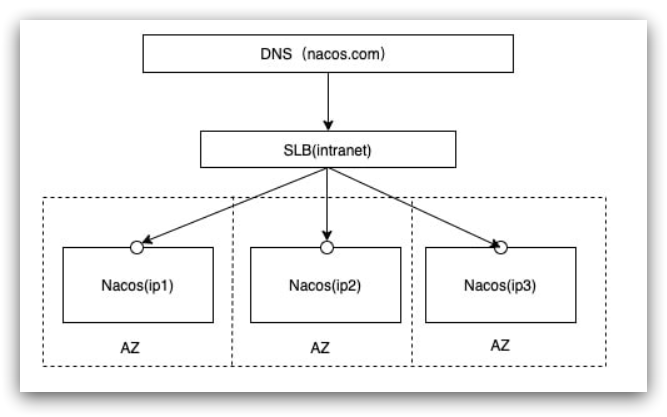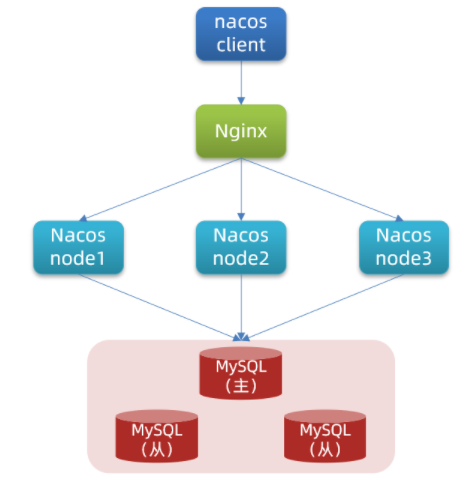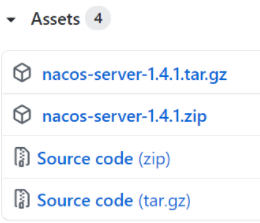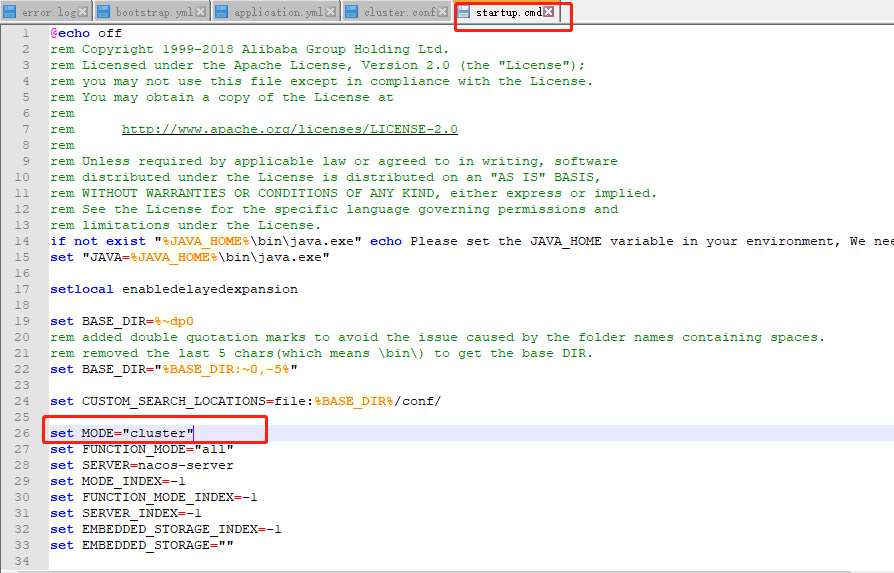Nacos cluster construction
The Nacos production environment must be deployed in the cluster state
Cluster structure diagram
Official Nacos cluster diagram

It contains three Nacos nodes, and then a load balancer agent three Nacos. Here, the load balancer can use nginx.
Nacos cluster diagram after using Nginx as load balancer

Simulate three nacos nodes on one computer. In the actual environment, three nodes should correspond to three servers
| node | ip | port |
|---|---|---|
| nacos1 | xxx.xxx.xxx.xxx | 8845 |
| nacos2 | xxx.xxx.xxx.xxx | 8846 |
| nacos3 | xxx.xxx.xxx.xxx | 8847 |
step
Basic steps to build a cluster:
- Build the database and initialize the database table structure
- Download the nacos installation package
- Configure nacos
- Start the nacos cluster
- nginx reverse proxy
Initialize database
Nacos default data is stored in the embedded database Derby, which is not a database available for production. The best practice officially recommended is to use a highly available database cluster with master and slave. Here we take a single point database as an example.
Create a new database, name it nacos, and then execute the following sql statement
CREATE TABLE `config_info` (
`id` bigint(20) NOT NULL AUTO_INCREMENT COMMENT 'id',
`data_id` varchar(255) NOT NULL COMMENT 'data_id',
`group_id` varchar(255) DEFAULT NULL,
`content` longtext NOT NULL COMMENT 'content',
`md5` varchar(32) DEFAULT NULL COMMENT 'md5',
`gmt_create` datetime NOT NULL DEFAULT CURRENT_TIMESTAMP COMMENT 'Creation time',
`gmt_modified` datetime NOT NULL DEFAULT CURRENT_TIMESTAMP COMMENT 'Modification time',
`src_user` text COMMENT 'source user',
`src_ip` varchar(50) DEFAULT NULL COMMENT 'source ip',
`app_name` varchar(128) DEFAULT NULL,
`tenant_id` varchar(128) DEFAULT '' COMMENT 'Tenant field',
`c_desc` varchar(256) DEFAULT NULL,
`c_use` varchar(64) DEFAULT NULL,
`effect` varchar(64) DEFAULT NULL,
`type` varchar(64) DEFAULT NULL,
`c_schema` text,
PRIMARY KEY (`id`),
UNIQUE KEY `uk_configinfo_datagrouptenant` (`data_id`,`group_id`,`tenant_id`)
) ENGINE=InnoDB DEFAULT CHARSET=utf8 COLLATE=utf8_bin COMMENT='config_info';
/******************************************/
/* Full database name = nacos_config */
/* Table name = config_info_aggr */
/******************************************/
CREATE TABLE `config_info_aggr` (
`id` bigint(20) NOT NULL AUTO_INCREMENT COMMENT 'id',
`data_id` varchar(255) NOT NULL COMMENT 'data_id',
`group_id` varchar(255) NOT NULL COMMENT 'group_id',
`datum_id` varchar(255) NOT NULL COMMENT 'datum_id',
`content` longtext NOT NULL COMMENT 'content',
`gmt_modified` datetime NOT NULL COMMENT 'Modification time',
`app_name` varchar(128) DEFAULT NULL,
`tenant_id` varchar(128) DEFAULT '' COMMENT 'Tenant field',
PRIMARY KEY (`id`),
UNIQUE KEY `uk_configinfoaggr_datagrouptenantdatum` (`data_id`,`group_id`,`tenant_id`,`datum_id`)
) ENGINE=InnoDB DEFAULT CHARSET=utf8 COLLATE=utf8_bin COMMENT='Add tenant field';
/******************************************/
/* Full database name = nacos_config */
/* Table name = config_info_beta */
/******************************************/
CREATE TABLE `config_info_beta` (
`id` bigint(20) NOT NULL AUTO_INCREMENT COMMENT 'id',
`data_id` varchar(255) NOT NULL COMMENT 'data_id',
`group_id` varchar(128) NOT NULL COMMENT 'group_id',
`app_name` varchar(128) DEFAULT NULL COMMENT 'app_name',
`content` longtext NOT NULL COMMENT 'content',
`beta_ips` varchar(1024) DEFAULT NULL COMMENT 'betaIps',
`md5` varchar(32) DEFAULT NULL COMMENT 'md5',
`gmt_create` datetime NOT NULL DEFAULT CURRENT_TIMESTAMP COMMENT 'Creation time',
`gmt_modified` datetime NOT NULL DEFAULT CURRENT_TIMESTAMP COMMENT 'Modification time',
`src_user` text COMMENT 'source user',
`src_ip` varchar(50) DEFAULT NULL COMMENT 'source ip',
`tenant_id` varchar(128) DEFAULT '' COMMENT 'Tenant field',
PRIMARY KEY (`id`),
UNIQUE KEY `uk_configinfobeta_datagrouptenant` (`data_id`,`group_id`,`tenant_id`)
) ENGINE=InnoDB DEFAULT CHARSET=utf8 COLLATE=utf8_bin COMMENT='config_info_beta';
/******************************************/
/* Full database name = nacos_config */
/* Table name = config_info_tag */
/******************************************/
CREATE TABLE `config_info_tag` (
`id` bigint(20) NOT NULL AUTO_INCREMENT COMMENT 'id',
`data_id` varchar(255) NOT NULL COMMENT 'data_id',
`group_id` varchar(128) NOT NULL COMMENT 'group_id',
`tenant_id` varchar(128) DEFAULT '' COMMENT 'tenant_id',
`tag_id` varchar(128) NOT NULL COMMENT 'tag_id',
`app_name` varchar(128) DEFAULT NULL COMMENT 'app_name',
`content` longtext NOT NULL COMMENT 'content',
`md5` varchar(32) DEFAULT NULL COMMENT 'md5',
`gmt_create` datetime NOT NULL DEFAULT CURRENT_TIMESTAMP COMMENT 'Creation time',
`gmt_modified` datetime NOT NULL DEFAULT CURRENT_TIMESTAMP COMMENT 'Modification time',
`src_user` text COMMENT 'source user',
`src_ip` varchar(50) DEFAULT NULL COMMENT 'source ip',
PRIMARY KEY (`id`),
UNIQUE KEY `uk_configinfotag_datagrouptenanttag` (`data_id`,`group_id`,`tenant_id`,`tag_id`)
) ENGINE=InnoDB DEFAULT CHARSET=utf8 COLLATE=utf8_bin COMMENT='config_info_tag';
/******************************************/
/* Full database name = nacos_config */
/* Table name = config_tags_relation */
/******************************************/
CREATE TABLE `config_tags_relation` (
`id` bigint(20) NOT NULL COMMENT 'id',
`tag_name` varchar(128) NOT NULL COMMENT 'tag_name',
`tag_type` varchar(64) DEFAULT NULL COMMENT 'tag_type',
`data_id` varchar(255) NOT NULL COMMENT 'data_id',
`group_id` varchar(128) NOT NULL COMMENT 'group_id',
`tenant_id` varchar(128) DEFAULT '' COMMENT 'tenant_id',
`nid` bigint(20) NOT NULL AUTO_INCREMENT,
PRIMARY KEY (`nid`),
UNIQUE KEY `uk_configtagrelation_configidtag` (`id`,`tag_name`,`tag_type`),
KEY `idx_tenant_id` (`tenant_id`)
) ENGINE=InnoDB DEFAULT CHARSET=utf8 COLLATE=utf8_bin COMMENT='config_tag_relation';
/******************************************/
/* Full database name = nacos_config */
/* Table name = group_capacity */
/******************************************/
CREATE TABLE `group_capacity` (
`id` bigint(20) unsigned NOT NULL AUTO_INCREMENT COMMENT 'Primary key ID',
`group_id` varchar(128) NOT NULL DEFAULT '' COMMENT 'Group ID,An empty character indicates the entire cluster',
`quota` int(10) unsigned NOT NULL DEFAULT '0' COMMENT 'Quota, 0 means the default value is used',
`usage` int(10) unsigned NOT NULL DEFAULT '0' COMMENT 'Usage',
`max_size` int(10) unsigned NOT NULL DEFAULT '0' COMMENT 'The maximum size of a single configuration, in bytes. 0 means the default value is used',
`max_aggr_count` int(10) unsigned NOT NULL DEFAULT '0' COMMENT 'The maximum number of aggregate sub configurations, 0 means the default value is used',
`max_aggr_size` int(10) unsigned NOT NULL DEFAULT '0' COMMENT 'The upper limit of the sub configuration size of a single aggregate data, in bytes. 0 means the default value is used',
`max_history_count` int(10) unsigned NOT NULL DEFAULT '0' COMMENT 'Maximum change history quantity',
`gmt_create` datetime NOT NULL DEFAULT CURRENT_TIMESTAMP COMMENT 'Creation time',
`gmt_modified` datetime NOT NULL DEFAULT CURRENT_TIMESTAMP COMMENT 'Modification time',
PRIMARY KEY (`id`),
UNIQUE KEY `uk_group_id` (`group_id`)
) ENGINE=InnoDB DEFAULT CHARSET=utf8 COLLATE=utf8_bin COMMENT='Cluster, each Group Capacity information table';
/******************************************/
/* Full database name = nacos_config */
/* Table name = his_config_info */
/******************************************/
CREATE TABLE `his_config_info` (
`id` bigint(64) unsigned NOT NULL,
`nid` bigint(20) unsigned NOT NULL AUTO_INCREMENT,
`data_id` varchar(255) NOT NULL,
`group_id` varchar(128) NOT NULL,
`app_name` varchar(128) DEFAULT NULL COMMENT 'app_name',
`content` longtext NOT NULL,
`md5` varchar(32) DEFAULT NULL,
`gmt_create` datetime NOT NULL DEFAULT CURRENT_TIMESTAMP,
`gmt_modified` datetime NOT NULL DEFAULT CURRENT_TIMESTAMP,
`src_user` text,
`src_ip` varchar(50) DEFAULT NULL,
`op_type` char(10) DEFAULT NULL,
`tenant_id` varchar(128) DEFAULT '' COMMENT 'Tenant field',
PRIMARY KEY (`nid`),
KEY `idx_gmt_create` (`gmt_create`),
KEY `idx_gmt_modified` (`gmt_modified`),
KEY `idx_did` (`data_id`)
) ENGINE=InnoDB DEFAULT CHARSET=utf8 COLLATE=utf8_bin COMMENT='Multi tenant transformation';
/******************************************/
/* Full database name = nacos_config */
/* Table name = tenant_capacity */
/******************************************/
CREATE TABLE `tenant_capacity` (
`id` bigint(20) unsigned NOT NULL AUTO_INCREMENT COMMENT 'Primary key ID',
`tenant_id` varchar(128) NOT NULL DEFAULT '' COMMENT 'Tenant ID',
`quota` int(10) unsigned NOT NULL DEFAULT '0' COMMENT 'Quota, 0 means the default value is used',
`usage` int(10) unsigned NOT NULL DEFAULT '0' COMMENT 'Usage',
`max_size` int(10) unsigned NOT NULL DEFAULT '0' COMMENT 'The maximum size of a single configuration, in bytes. 0 means the default value is used',
`max_aggr_count` int(10) unsigned NOT NULL DEFAULT '0' COMMENT 'Maximum number of aggregate sub configurations',
`max_aggr_size` int(10) unsigned NOT NULL DEFAULT '0' COMMENT 'The upper limit of the sub configuration size of a single aggregate data, in bytes. 0 means the default value is used',
`max_history_count` int(10) unsigned NOT NULL DEFAULT '0' COMMENT 'Maximum change history quantity',
`gmt_create` datetime NOT NULL DEFAULT CURRENT_TIMESTAMP COMMENT 'Creation time',
`gmt_modified` datetime NOT NULL DEFAULT CURRENT_TIMESTAMP COMMENT 'Modification time',
PRIMARY KEY (`id`),
UNIQUE KEY `uk_tenant_id` (`tenant_id`)
) ENGINE=InnoDB DEFAULT CHARSET=utf8 COLLATE=utf8_bin COMMENT='Tenant capacity information table';
CREATE TABLE `tenant_info` (
`id` bigint(20) NOT NULL AUTO_INCREMENT COMMENT 'id',
`kp` varchar(128) NOT NULL COMMENT 'kp',
`tenant_id` varchar(128) default '' COMMENT 'tenant_id',
`tenant_name` varchar(128) default '' COMMENT 'tenant_name',
`tenant_desc` varchar(256) DEFAULT NULL COMMENT 'tenant_desc',
`create_source` varchar(32) DEFAULT NULL COMMENT 'create_source',
`gmt_create` bigint(20) NOT NULL COMMENT 'Creation time',
`gmt_modified` bigint(20) NOT NULL COMMENT 'Modification time',
PRIMARY KEY (`id`),
UNIQUE KEY `uk_tenant_info_kptenantid` (`kp`,`tenant_id`),
KEY `idx_tenant_id` (`tenant_id`)
) ENGINE=InnoDB DEFAULT CHARSET=utf8 COLLATE=utf8_bin COMMENT='tenant_info';
CREATE TABLE `users` (
`username` varchar(50) NOT NULL PRIMARY KEY,
`password` varchar(500) NOT NULL,
`enabled` boolean NOT NULL
);
CREATE TABLE `roles` (
`username` varchar(50) NOT NULL,
`role` varchar(50) NOT NULL,
UNIQUE INDEX `idx_user_role` (`username` ASC, `role` ASC) USING BTREE
);
CREATE TABLE `permissions` (
`role` varchar(50) NOT NULL,
`resource` varchar(255) NOT NULL,
`action` varchar(8) NOT NULL,
UNIQUE INDEX `uk_role_permission` (`role`,`resource`,`action`) USING BTREE
);
INSERT INTO users (username, password, enabled) VALUES ('nacos', '$2a$10$EuWPZHzz32dJN7jexM34MOeYirDdFAZm2kuWj7VEOJhhZkDrxfvUu', TRUE);
INSERT INTO roles (username, role) VALUES ('nacos', 'ROLE_ADMIN');
Download nacos
Nacos has a download address on GitHub: https://github.com/alibaba/nacos/tags , you can choose any version to download.
Only version 1.4.1 is used in this example:

Configure Nacos
In the conf directory of nacos:
Add cluster Conf.example, renamed cluster Conf and add content
127.0.0.1:8845 127.0.0.1.8846 127.0.0.1.8847
Modify the application. In the conf directory Properties file
spring.datasource.platform=mysql db.num=1 db.url.0=jdbc:mysql://127.0.0.1:3306/nacos?characterEncoding=utf8&connectTimeout=1000&socketTimeout=3000&autoReconnect=true&useUnicode=true&useSSL=false&serverTimezone=UTC db.user.0=root db.password.0=
Start Nacos
Copy three copies of the Nacos folder, named nacos1, nacos2 and nacos3 respectively
Then modify the application. In the three folders respectively properties,
nacos1:
server.port=8845
nacos2:
server.port=8846
nacos3:
server.port=8847
Then start three nacos nodes respectively:
startup.cmd
Nginx reverse proxy
Modify the conf / nginx Conf file, configured as follows:
http {
upstream nacos-cluster {
server 127.0.0.1:8845;
server 127.0.0.1:8846;
server 127.0.0.1:8847;
}
server {
listen 80;
server_name localhost;
location /nacos {
proxy_pass http://nacos-cluster;
}
}
}
Then access in the browser: http://localhost/nacos Just.
Change Nacos to cluster mode
For nacos1, nacos2 and nacos3, you need to modify the start in the bin directory of Nacos CMD file

Modify code
Bootstrap The YML file configuration is as follows:
spring:
application:
name: userservice # Service name
profiles:
active: dev # development environment
cloud:
nacos:
discovery:
server-addr: 127.0.0.1:80
config:
file-extension: yaml # file extension
server-addr: 127.0.0.1:80
namespace: ad04ea8d-50ee-4dd6-bf38-a71f8337c117
If the browser can access the nacos control page, but the local service cannot register, the following problems occur:
java.net.ConnectException: Connection refused: connect at java.net.DualStackPlainSocketImpl.waitForConnect(Native Method) ~[na:1.8.0_181] at java.net.DualStackPlainSocketImpl.socketConnect(DualStackPlainSocketImpl.java:85) ~[na:1.8.0_181] at java.net.AbstractPlainSocketImpl.doConnect(AbstractPlainSocketImpl.java:350) ~[na:1.8.0_181] at java.net.AbstractPlainSocketImpl.connectToAddress(AbstractPlainSocketImpl.java:206) ~[na:1.8.0_181] at java.net.AbstractPlainSocketImpl.connect(AbstractPlainSocketImpl.java:188) ~[na:1.8.0_181] at java.net.PlainSocketImpl.connect(PlainSocketImpl.java:172) ~[na:1.8.0_181] at java.net.SocksSocketImpl.connect(SocksSocketImpl.java:392) ~[na:1.8.0_181] at java.net.Socket.connect(Socket.java:589) ~[na:1.8.0_181] at sun.net.NetworkClient.doConnect(NetworkClient.java:175) ~[na:1.8.0_181] at sun.net.www.http.HttpClient.openServer(HttpClient.java:463) ~[na:1.8.0_181] at sun.net.www.http.HttpClient.openServer(HttpClient.java:558) ~[na:1.8.0_181] at sun.net.www.http.HttpClient.<init>(HttpClient.java:242) ~[na:1.8.0_181] at sun.net.www.http.HttpClient.New(HttpClient.java:339) ~[na:1.8.0_181] at sun.net.www.http.HttpClient.New(HttpClient.java:357) ~[na:1.8.0_181] at sun.net.www.protocol.http.HttpURLConnection.getNewHttpClient(HttpURLConnection.java:1220) ~[na:1.8.0_181] at sun.net.www.protocol.http.HttpURLConnection.plainConnect0(HttpURLConnection.java:1156) ~[na:1.8.0_181] at sun.net.www.protocol.http.HttpURLConnection.plainConnect(HttpURLConnection.java:1050) ~[na:1.8.0_181] at sun.net.www.protocol.http.HttpURLConnection.connect(HttpURLConnection.java:984) ~[na:1.8.0_181] at com.alibaba.nacos.common.http.client.request.JdkHttpClientRequest.execute(JdkHttpClientRequest.java:112) ~[nacos-common-1.4.1.jar:na] at com.alibaba.nacos.common.http.client.NacosRestTemplate.execute(NacosRestTemplate.java:482) ~[nacos-common-1.4.1.jar:na] at com.alibaba.nacos.common.http.client.NacosRestTemplate.exchangeForm(NacosRestTemplate.java:427) ~[nacos-common-1.4.1.jar:na] at com.alibaba.nacos.client.naming.net.NamingProxy.callServer(NamingProxy.java:603) [nacos-client-1.4.1.jar:na] at com.alibaba.nacos.client.naming.net.NamingProxy.reqApi(NamingProxy.java:526) [nacos-client-1.4.1.jar:na] at com.alibaba.nacos.client.naming.net.NamingProxy.reqApi(NamingProxy.java:498) [nacos-client-1.4.1.jar:na] at com.alibaba.nacos.client.naming.net.NamingProxy.reqApi(NamingProxy.java:493) [nacos-client-1.4.1.jar:na] at com.alibaba.nacos.client.naming.net.NamingProxy.queryList(NamingProxy.java:407) [nacos-client-1.4.1.jar:na] at com.alibaba.nacos.client.naming.core.HostReactor.updateService(HostReactor.java:378) [nacos-client-1.4.1.jar:na] at com.alibaba.nacos.client.naming.core.HostReactor$UpdateTask.run(HostReactor.java:460) [nacos-client-1.4.1.jar:na] at java.util.concurrent.Executors$RunnableAdapter.call(Executors.java:511) [na:1.8.0_181] at java.util.concurrent.FutureTask.run(FutureTask.java:266) [na:1.8.0_181] at java.util.concurrent.ScheduledThreadPoolExecutor$ScheduledFutureTask.access$201(ScheduledThreadPoolExecutor.java:180) [na:1.8.0_181] at java.util.concurrent.ScheduledThreadPoolExecutor$ScheduledFutureTask.run(ScheduledThreadPoolExecutor.java:293) [na:1.8.0_181] at java.util.concurrent.ThreadPoolExecutor.runWorker(ThreadPoolExecutor.java:1149) [na:1.8.0_181] at java.util.concurrent.ThreadPoolExecutor$Worker.run(ThreadPoolExecutor.java:624) [na:1.8.0_181] at java.lang.Thread.run(Thread.java:748) [na:1.8.0_181]
This is because spring needs to be configured during configuration cloud. nacos. discovery. server-addr=xxx. xxx. xxx. xxx:80
optimization
-
During the actual deployment, you need to set a domain name for the nginx server as the reverse proxy, so that if there is a server to migrate the nacos client in the future, there is no need to change the configuration
-
Each node of Nacos should be deployed to multiple different servers for disaster recovery and isolation